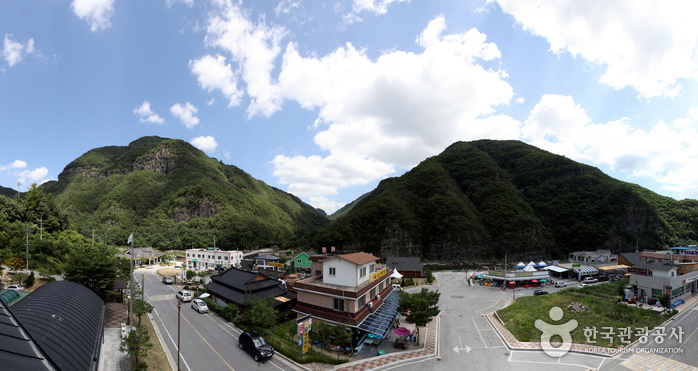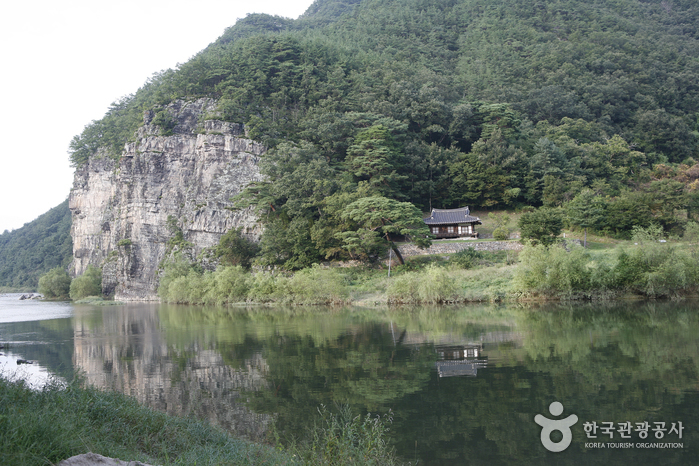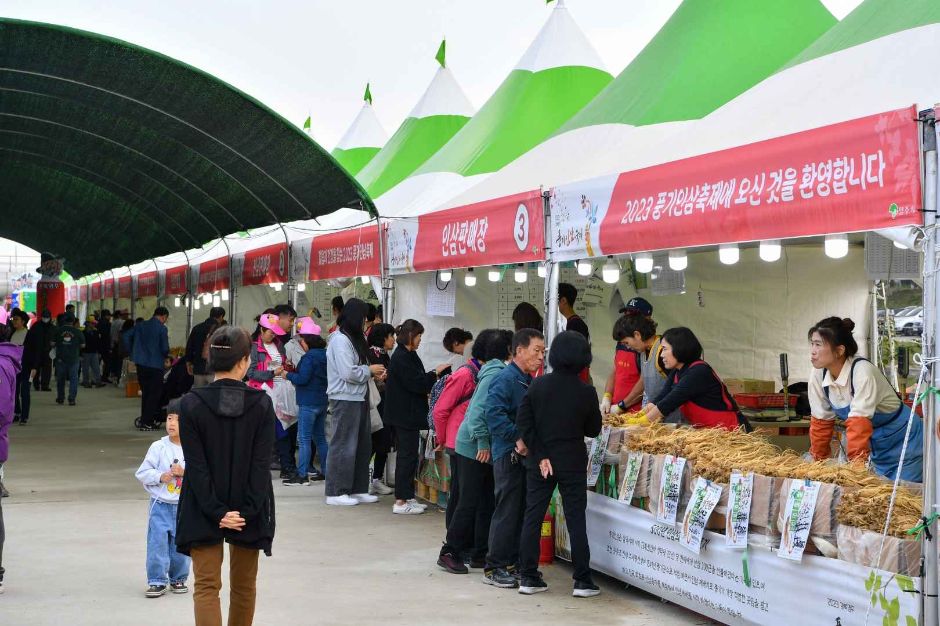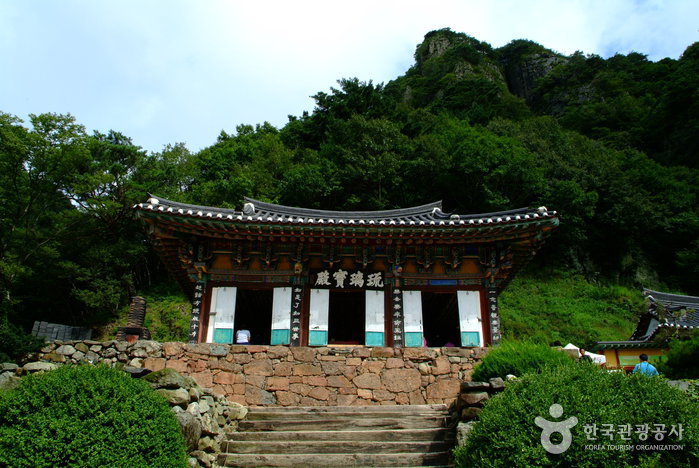Cheongnyangsan Provincial Park (청량산도립공원)
17.9Km 2022-07-26
39, Gwangseok-gil, Bonghwa-gun, Gyeongsangbuk-do
+82-54-679-6651
Cheongnyangsan Mountain, with an altitude of 870 meters, is hidden away from civilization. Attractions in the mountain are 12 peaks including Geumtapbong Peak, eight caves, Gwangchangpokpo Falls, and Cheongnyangsa Temple, built by Buddhist monk Wonhyo during King Munmu’s third year of reign during the Silla Period (57 BC - AD 935).
Behind the Cheongnyangsan Provincial Park’s entrance boulder is a monument with a poem inscribed on it by the famous scholar Toegye Yi Hwang of the Joseon period called Cheongnyangsanga. Aside from Toegye Yi Hwang, Wonhyo and Uisang, caligraphy master Gimsaeng, scholar Choi Chi-won, and many others came to this mountain to cultivate their arts. Their presence still lingers in legends, being retold to this day.
Menge Village (맹개마을)
18.6Km 2025-01-09
162-135 Gasong-gil, Dosan-myeon, Andong-si, Gyeongsangbuk-do
Nestled between Cheongnyangsan Mountain and Nakdonggang River, Menge Village in Andong is a hidden gem that offers unique immersive experiences. Accessible only through a boat or a tractor, the experiential village accepts visitors only with accommodation or experience program reservation. The village offers beautiful scenery throughout the year, however, the golden wheat fields of June and buckwheat flower blossoms in September are simply breathtaking. Visitors can also see music performances. Through the Menge Village Farm Day Trip, visitors can enjoy various experience programs such as the jinmaek soju-making experience program and organic sourdough bread and wheat cookie-making, all available with reservation only.
Nongam Head House (농암종택)
19.1Km 2023-05-18
162-133 , Gasong-gil, Andong-si, Gyeongsangbuk-do
+82-54-843-1202
This is the head house of Nongam I Hyeon-bo, located in Gasong-gil, Dosan-myeon, Andong-si. I Hyeon-bo served as Saganwonjeongeon in 1504 (the 10th year of Yeonsangun) and was exiled to Andong due to the king's anger. The place where Nongam Head House was located was Buncheon Village, but Buncheon Village was submerged due to the construction of Andong Dam in 1976. Since then, the head house, shrine, and Geunggudang, which had all been relocated to various places in Andong, were moved to one place by I Seong-won, a descendant of the Yeongcheon I family. In 2007, Bungang Confucian Academy was rebuilt and is now called Bungang Village and open to the public.
Gosanjeong Pavilion (고산정)
19.3Km 2025-10-23
177-42 Gasong-gil, Dosan-myeon, Andong-si, Gyeongsangbuk-do
Gosanjeong Pavilion was built by Geum Nan-su in 1564 as a place for study. The pavilion is located below the Gasonghyeop escarpment, one of the eight scenic sites of Andong, along the Nakdonggang River. Views from the pavilion include Woebyeongsan and Naebyeongsan Mountains and a lush pine forest.
Yeongju Punggi Insam Festival (경북영주 풍기인삼축제)
19.3Km 2025-07-11
Seongnae-ri, Punggi-eup, Yeongju-si, Gyeongsangbuk-do
+82-54-639-6612
Ginseng is a well-known traditional Korean medicinal herb. High quality ginseng in Korea is mostly produced in Punggi, a region in Yeongju, Gyeongsangbuk-do, and the place where the Punggi Ginseng Festival takes place. The festival features health-related exhibits and offers opportunities to taste healthy ginseng dishes at the ginseng cooking exhibition. Visitors can also participate in Punggi ginseng-related interesting activities such as making Punggi ginseng wine and peeling ginseng in the traditional Korean way. The festival offers a variety of ginseng products, including fresh ginseng, original ginseng, red ginseng, and ginseng processed foods, which are all grown by local farmers in Yeongju and sold at reasonable prices. Additionally, the festival showcases local specialties and symbols such as ginseng and Yeongju apples through oil lantern displays along Namwoncheon Stream. With so many attractions, visitors are sure to have a great time at the festival.
Bonghwa Cheongnyangsa Temple (청량사(봉화))
19.7Km 2022-12-27
199-152, Cheongnyangsan-gil, Bonghwa-gun, Gyeongsangbuk-do
+82-54-672-1446
Located in Cheongnyangsan Mountain Provincial Park, Cheongnyangsa Temple was built by the great monk Wonhyo in 663, the 3rd year of King Munmu of the Silla Kingdom. According to the principles of feng shui, the area is an ideal place for a temple – with the 12 mountain peaks surrounding the temple like the petals of a lotus flower.
The temple is home to two precious historical remains; one is the board of Yuribojeon that King Gongmin of Goryeo wrote upon and the other is Jibul. Yuribojeon is the building where Yaksa-yorae-bul (the Medicine Buddha Statute) is housed and Jibul is a Buddha statute made of paper that was painted with gold.
At the back of the temple is Bosalbong Peak looking out towards Cheongnyangsan Mountain. A 30-minute walk along the hiking trail will lead the hikers to Eungjinjeon, a hermitage with a beautiful view where the great monk Wonhyo once stayed. Behind Eungjinjeon stands Geumtapbong Peak and the sheer cliffs below. The peak was named Geumtapbong (meaning ‘golden pagoda’ in Korean) since it looks like a nine-story pagoda with pine trees growing around the base. In the autumn, the beautiful red, gold and orange hues of the maple trees are a true sight to behold.





 English
English
 한국어
한국어 日本語
日本語 中文(简体)
中文(简体) Deutsch
Deutsch Français
Français Español
Español Русский
Русский